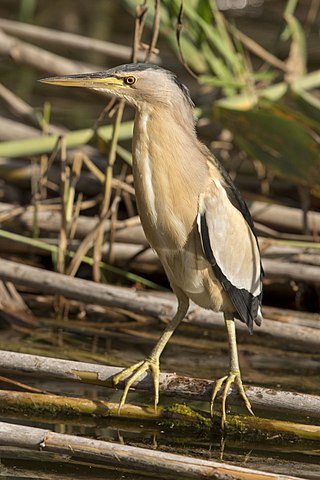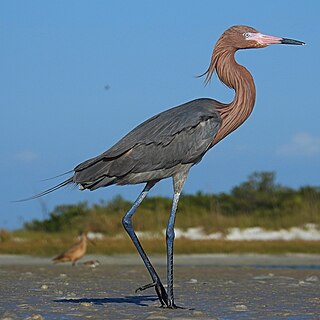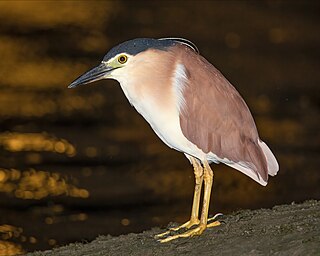
Herons are long-legged, long-necked, freshwater and coastal birds in the family Ardeidae, with 72 recognised species, some of which are referred to as egrets or bitterns rather than herons. Members of the genera Botaurus and Ixobrychus are referred to as bitterns, and, together with the zigzag heron, or zigzag bittern, in the monotypic genus Zebrilus, form a monophyletic group within the Ardeidae. Egrets do not form a biologically distinct group from herons, and tend to be named differently because they are mainly white or have decorative plumes in breeding plumage. Herons, by evolutionary adaptation, have long beaks.

The great egret (Ardea alba), also known as the common egret, large egret, or great white egret or great white heron, is a large, widely distributed egret. The four subspecies are found in Asia, Africa, the Americas, and southern Europe. Recently it is also spreading to more northern areas of Europe. Distributed across most of the tropical and warmer temperate regions of the world, it builds tree nests in colonies close to water.

The greater yellowlegs is a large shorebird in the family Scolopacidae. It breeds in central Canada and southern Alaska and winters in southern North America, Central America, the West Indies and South America.

The lesser yellowlegs is a medium-sized shorebird. It breeds in the boreal forest region of North America.

The little bittern or common little bittern is a wading bird in the heron family, Ardeidae. Ixobrychus is from Ancient Greek ixias, a reed-like plant and brukhomai 'to bellow', and minutus is Latin for 'small'.

The cinnamon bittern or chestnut bittern is a small Old World bittern, breeding in tropical and subtropical Asia from India east to China and Indonesia. It is mainly resident, but some northern birds migrate short distances.

The watercock is a waterbird in the rail and crake family, Rallidae that is widely distributed across Southeast Asia. It is the only member of the genus Gallicrex.

The reddish egret is a medium-sized heron that is a resident breeder in Central America, the Bahamas, the Caribbean, the Gulf Coast of the United States, and Mexico. The egret is known for its unusual foraging behavior compared to other herons as well as its association with mud flats, its habitat of choice.

The agami heron is a medium-sized heron. It is a resident breeding bird from Central America south to Peru and Brazil. It is sometimes known as the chestnut-bellied heron, and is the only member of the genus Agamia. In Brazil it is sometimes called Soco beija-flor, meaning 'hummingbird heron', thanks to its unique coloration pattern.

Ixobrychus is a genus of bitterns, a group of wading bird in the heron family Ardeidae. It has a single representative species in each of North America, South America, Eurasia, and Australasia. The tropical species are largely resident, but the two northern species are partially migratory, with many birds moving south to warmer areas in winter.

The least bittern is a small heron, the smallest member of the family Ardeidae found in the Americas.

The red-billed teal or red-billed duck is a dabbling duck which is an abundant resident breeder in southern and eastern Africa typically south of 10° S. This duck is not migratory, but will fly great distances to find suitable waters. It is highly gregarious outside the breeding season and forms large flocks.

The plumbeous kite is a bird of prey in the family Accipitridae that is resident in much of northern South America. It is migratory in the northern part of its range which extends north to Mexico. It feeds on insects which it catches either from a perch or while in flight.

The Pacific reef heron, also known as the eastern reef heron or eastern reef egret, is a species of heron found throughout southern Asia and Oceania. It occurs in two colour morphs with either slaty grey or pure white plumage. The sexes are similar in appearance.

The nankeen night heron is a heron that belongs to the genus Nycticorax and the family Ardeidae. Due to its distinctive reddish-brown colour, it is also commonly referred to as the rufous night heron. It is primarily nocturnal and is observed in a broad range of habitats, including forests, meadows, shores, reefs, marshes, grasslands, and swamps. The species is 55 to 65 cm in length, with rich cinnamon upperparts and white underparts. The nankeen night heron has a stable population size, and is classified as a species of least concern by the International Union for Conservation of Nature (IUCN).

Ardea is a genus of herons. These herons are generally large in size, typically 80–100 cm or more in length.

The capped wheatear is a small insectivorous passerine bird that is widely distributed over southern Africa. It was formerly classed as a member of the thrush family Turdidae, but is now placed in the Old World flycatcher family, Muscicapidae.

The zigzag heron is a species of heron in the family Ardeidae, also including egrets and bitterns. It is in the monotypic genus Zebrilus. It is found in Bolivia, Brazil, Colombia, Ecuador, French Guiana, Guyana, Peru, Suriname, and Venezuela. Its natural habitat is subtropical or tropical swamps.

The black-faced ibis is a species of bird in the family Threskiornithidae. It is found in grassland and fields in southern and western South America. It has been included as a subspecies of the similar buff-necked ibis, but today all major authorities accept the split. The black-faced ibis also includes the Andean ibis as a subspecies. Some taxonomic authorities still do so.

The pale thrush is a passerine bird of the eastern Palearctic belonging to the genus Turdus in the thrush family Turdidae. It is closely related to the eye-browed thrush and grey-backed thrush.






















